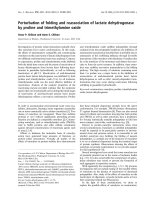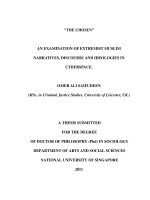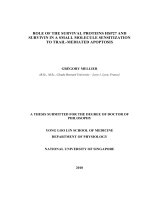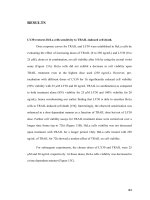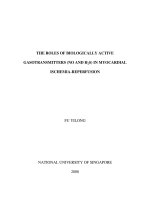Modification of graphene oxide by curcumin and application in polyurethane coating
Bạn đang xem bản rút gọn của tài liệu. Xem và tải ngay bản đầy đủ của tài liệu tại đây (845.22 KB, 8 trang )
Vietnam Journal of Science and Technology 58 (3) (2020) 274-281
doi:10.15625/2525-2518/58/3/14645
MODIFICATION OF GRAPHENE OXIDE BY CURCUMIN AND
APPLICATION IN POLYURETHANE COATING
Thuy Duong Nguyen1, Boi An Tran2, 3, Thanh Thao Phan2, 3, Ke Oanh Vu1,
Anh Son Nguyen1, Tuan Anh Nguyen4, Thi Xuan Hang To1, 3, *
1
Institute for Tropical Technology, Vietnam Academy of Science and Technology
18 Hoang Quoc Viet, Cau Giay, Ha Noi, Viet Nam
2
Institute of Chemical Technology, Vietnam Academy of Science and Technology
1 Mac Dinh Chi, District 1, Ho Chi Minh City, Viet Nam
3
Graduate University of Science and Technology, Vietnam Academy of Science and Technology
18 Hoang Quoc Viet, Cau Giay, Ha Noi, Viet Nam
4
Central Pre-University school for ethnic minority, 2 Tran Phu, Viet Tri, Phu Tho, Viet Nam
*
Email:
Received: 26 November 2019; Accepted for publication: 7 February 2020
Abstract. Curcumin modified graphene oxide (GO-CR) was prepared using the adsorption
method and polyurethane (PU) coating containing 0.3 wt% GO-CR was prepared on carbon
steel. Synthesized GO-CR was characterized by Fourier transform infrared spectroscopy (FTIR),
X-ray diffraction (XRD), scanning electron microscopy (SEM) and zeta potential measurement.
Corrosion protection property of polyurethane coating containing GO-CR was evaluated and
compared with that of blank polyurethane coating and coating containing GO by electrochemical
impedance spectroscopy. The results showed that GO-CR has a layer structure like GO with
lower crystallinity. In GO-CR, structure curcumin was attached on GO surface. The presence of
curcumin on GO-CR surface provided corrosion inhibition action for PU coating and also
improved the dispersion of GO in PU coating.
Keywords: graphene oxide, curcumin, corrosion protection, polyurethane coatings.
Classification numbers: 2.4.4, 2.9.4, 2.5.3.
1. INTRODUCTION
Corrosion of metals causes high economic loss, especially in tropical weather conditions.
Therefore, corrosion protection of metals is important and necessary. A lot of researches have
been concentrated on using graphene oxide to develop environmentally friendly organic
coatings. Graphene oxide can be formed on steel to provide good corrosion protection coatings
[1 - 3]. Carbonyl iron (CI) particles were treated with 4-aminobenzoic acid (A-CI) then coated
by graphene oxide by adsorption method. Electrochemical impedance measurements showed
that GO coating passivated A-CI surface and increased the charge transfer resistance of A-CI
sample [1]. GO coating was formed on mild steel surfaces by electrophoretic (EPD) method and
Modification of graphene oxide by curcumin and application in polyurethane coating
heat treated at 200 oC for 4 h. GO coating increased charge transfer of mild steel and decreased
it’s corrosion rate by 2 times [2]. In other works, GO prepared with different drying procedures
were deposited on steel substrate by electrophoretic method for corrosion protection. The results
showed that the drying temperature influenced the dispersion degree of GO in water, as well as
on the protection performance of GO coating. GO dried at lower temperature provided higher
barrier and corrosion protection coating on steel [3]. GO has also been studied as an additive to
improve corrosion protection properties of organic coatings. GO was often modified or
combined with other additives in order to improve the effect of GO in organic coatings [4 - 7].
Graphene oxide modified by P-phenylenediamine improved corrosion protection of epoxy
coatings [4]. Surface treatment by aminosilane and 1,4-butanediol diglycidyl improved their GO
dispersion in epoxy matrix and effects on corrosion resistance of epoxy coatings [5]. GO
modified by 3-(Triethoxysilyl)propyl isocyanate and 3-aminopropyltriethoxysilane significantly
improved corrosion resistance and adhesion properties of silane/epoxy coatings on steel surface
[6]. GO was grafted with polyethylenimin and applied in waterborne epoxy coating for corrosion
protection of carbon steel [7].
Recently many researches focused on the development of corrosion inhibitors based on
plant extracts. Curcumin, a polyphenol compound derived from turmeric, showed inhibition
effect for carbon steel [8 - 10]. M.K. Mohammed et al. studied the corrosion inhibition of carbon
steel in 3.5 % NaCl by curcumin. It was shown that curcumin can be adsorbed on steel surface,
and inhibition efficiency was about 86 % at concentration of 2.7 × 10-5 M [8]. Curcumin formed
a protective film on steel surface and showed both anodic and cathodic inhibition effect in 0.5 M
H2SO4 [9]. Combination of curcumin and Zn2+ exhibited corrosion inhibition efficiency of 93 %
for carbon steel in seawater [10].
In this study, GO was modified by curcumin (GO-CR) and applied in polyurethane
coatings for corrosion protection of carbon steel. Synthesized GO-CR was analyzed by FTIR,
XRD and SEM. The corrosion resistance of polyurethane coatings containing GO-CR was
evaluated by electrochemical impedance spectroscopy.
2. MATERIALS AND METHODS
2.1. Materials
Natural graphite was purchased by Sigma-Aldrich. KMnO4 and H2SO4 (95 - 98 %) were all
supplied by Merck. Curcumin was extracted from turmeric powder from Thanh Son, Phu Tho,
Viet Nam using acetone as a solvent.
The polyurethane coating was based on a hydroxyl-bearing polyacrylate (ACRY) as base
and an aliphatic polyisocyanate (ALIP) as hardener. They were obtained from Nippon
Polyurethane Industry (NPU).
2.2. Preparation of graphene oxide
Graphene oxide was synthesized from expanded graphite powder by modified Hummer’s
method according to the same procedure described in our previous report [11]. Graphite and
KMnO4 were gradually added into concentrated H2SO4 solution at 2 oC. Then the temperature of
the mixture was increased to 35 oC and kept for 2 hours. After that distilled water was poured to
the mixture with stirring over 1 h, and then H2O2 was poured to the mixture with stirring over 1
h. GO was filtered, washed with distilled water and dried in a vacuum oven at 50 oC for 24 h.
275
Thuy Duong Nguyen, Boi An Tran, Thanh Thao Phan, Ke Oanh Vu, Anh Son Nguyen,
Tuan Anh Nguyen, Thi Xuan Hang To
2.3. Preparation of curcumin modified graphene oxide
0.05 g GO was dispersed in 50 mL distilled water using ultrasonics during 20 min. 20 mL
ethanol solution containing 0.02 g curcumin was added progressively to the GO solution with
magnetic stirring. The mixture was then kept at room temperature with stirring for 24 h. After
that the GO-CR powder was centrifuged, washed with water, and dried at 80 oC in vacuum.
2.4. Preparation of polyurethane coatings containing GO-CR
Polyurethane coatings containing GO-CR and GO at concentration of 0.3 wt% were
prepared on carbon steel. The dimension steel sample was 15 × 10 × 0.2 cm. The steel samples
were abraded by abrasive papers 400 grades and washed with distilled water and ethanol and
then dried. GO and GO-CR were dispersed in ACRY resin under magnetic stirring and
ultrasonic condition, and then the hardener was added to resin containing GO or GO-CR. The
polyurethane coatings were applied on steel plates by spin coating method. These coatings were
dried at room temperature for 14 days. The thickness of dried coatings was 30 ± 3 µm.
2.5. Analytical characterization
The FTIR spectra were obtained using the KBr method on a Nexus 670 Nicolet
spectrometer operated at 1 cm-1 resolution in the 400–4000 cm−1 region.
XRD patterns were taken by using Siemens diffractometer D5000 with CuKα radiation
(0.15406 nm).
The scanning electron microscope images were taken by using Field emission scanning
electron microscope Hitachi S-4800.
The zeta potential measurements of the GO and GO-CR were realized by using
MALVERN Zetasizer Nano ZS.
2.6. Electrochemical impedance test
The corrosion resistance of coating samples was investigated by electrochemical
impedance test using a Biologic SP300. A three-electrode system was used: coated steel as
working electrode, saturated calomel (SCE) as reference electrode and platinum grid as counter
electrode. The electrochemical impedance test was done with frequency intervals from 10 mHz
to 100 kHz and the corrosion medium was 3 % NaCl solution. For each coating system, three
samples were tested.
3. RESULTS AND DISCUSSION
3.1. Characterization of curcumin modified graphene oxide
Structure of curcumin loaded GO was characterized at first by FTIR. FTIR spectra of
curcumin, GO and GO-CR are shown in Fig. 1. The spectrum of GO revealed the presence of
C=O, C-O and C=C at 1719, 1385 and 1624 cm-1 respectively [12]. In the spectrum of curcumin,
the band at 1628 cm-1 was characteristic of aliphatic C=O and C=C. The bands at 1510 and 1284
cm-1 were attributed to C=C and C-O, respectively [13]. Spectrum of GO-CR presented the
bands characteristic of C=O, C-O and C=C in GO at 1719, 1385 and 1624 cm-1. The bands
characteristic of C-O in CR were observed also in the spectrum of GO-CR. The band
characteristic of C=C and C=O of CR at 1628 cm-1 was overlapped by the band characteristic of
C=C in GO. These results revealed the presence of curcumin in GO-CR.
Modification of graphene oxide by curcumin and application in polyurethane coating
The XRD patterns of GO and GO-CR are presented in Fig. 2. It is observed that GO-CR
has the same interlayer distance of 0.79 nm as GO. The pattern of GO is sharper than that of
GO-CR. This result indicates that GO-CR maintains the structure of GO with lower crystallinity.
Figure 1. FT-IR spectra of curcumin, GO and GO-CR.
Figure 2. XRD patterns of GO and GO-CR.
SEM images of GO and GO-CR are shown in Fig. 3. GO has a layer structure with a large
surface. GO-CR exhibits also layer structure similar to GO. The surface of GO is smoother than
the one of GO-CR. This can be explained by the presence of curcumin on GO-CR surface [14].
GO
GO-CR
500 nm
500 nm
Figure 3. SEM photographs of GO and GO-CR.
277
Thuy Duong Nguyen, Boi An Tran, Thanh Thao Phan, Ke Oanh Vu, Anh Son Nguyen,
Tuan Anh Nguyen, Thi Xuan Hang To
Figure 4. Zeta potentials of GO and GO-CR.
Surface property of GO-CR was investigated by measuring zeta potential of GO and GOCR at a concentration of 0.03 % in distilled water (Fig. 4). The zeta potentials of GO and GOCR were -49.0 mV and -29.1 mV, respectively. In comparison with GO, the zeta potential of
GO-CR moved in a positive direction. The change of zeta potential indicates the presence of
curcumin on GO-CR surface [14].
3.2. Characterization of PU coatings containing GO-CR
The dispersion degree of GO-CR and GO in PU coating was investigated by SEM. The
SEM images of cross-section surface of PU coatings containing GO and GO-CR are shown in
Fig. 5. For PU coatings containing 0.3 wt% GO we can see the layer structure of GO and the
gaps between GO and PU resin. The size of the gaps were about 150-200 nm. For PU coating
containing GO-CR, the structures of GO-CR can be also observed, but the slits between GO-CR
and PU resin were much lower that of PU coatings with GO. The size of the slits was about 50100 nm. The results showed that modification by curcumin improved the dispersion of GO-CR
in PU matrix.
Figure 5. SEM images of polyurethane coatings with GO and GO-CR.
Corrosion resistance of coating samples was investigated by electrochemical impedance
test. Fig. 6 presents the impedance diagrams of PU coating, PU containing 0.3 % GO and PU
coating containing 0.3 % GO-CR after 35 days immersion in 3 % NaCl solution. The impedance
modulus of PU coating with GO and GO-CR were very high and much higher than that of blank
Modification of graphene oxide by curcumin and application in polyurethane coating
PU coatings and the impedance modulus of sample with GO-CR was higher than that of sample
with GO. The increase of impedance modulus of sample with GO-CR in comparison with that of
coating with GO can be explained the inhibition effect of curcumin on GO-CR surface [8]. From
impedance diagrams, impedance modulus at a frequency of 100 mHz (Z100 mHz) were extracted to
evaluate the corrosion resistance of samples [15]. The variations of Z100 mHz of samples during
the test are shown in Fig. 7.
After 1 h immersion in NaCl solution, the Z100mHz values of all samples were very close
and very high (> 109 Ω.cm2). During the first 14 days of testing, The Z100mHz values of all
samples did not change much. After 21 days, the Z100mHz value of blank PU sample decreased
significantly, while the Z100mHz values of PU samples with GO and GO-CR were stable. The
decrease of Z100mHz demonstrates the penetration of electrolyte in the coatings. After 42 days, the
Z100mHz of PU samples with GO and GO-CR were very high (> 109 Ω.cm2), much higher than
that of blank PU sample (<108 Ω.cm2). Sample with GO-CR exhibited higher Z100mHz than
sample with GO. Higher protection obtained by GO-CR compared with GO can be explained by
the inhibition effect of curcumin presented in GO-CR and better dispersion of GO-CR in PU
resin. The presence of curcumin on GO-CR surface provided corrosion inhibition action at the
steel/coating interface and improved the compatibility between PU and GO-CR.
Figure 6. Electrochemical impedance diagrams obtained after 35 days test in 3 % NaCl for coating
samples.
279
Thuy Duong Nguyen, Boi An Tran, Thanh Thao Phan, Ke Oanh Vu, Anh Son Nguyen,
Tuan Anh Nguyen, Thi Xuan Hang To
Figure 7. Variation of Z100mHz values with exposure time to NaCl solution of coating samples.
1. CONCLUSIONS
Graphene oxide modified by curcumin was successfully synthesized by adsorption method.
GO-CR has a layer structure like GO with curcumin attached on GO surface. Polyurethane
coatings with GO and GO-CR at concentration of 0.3 wt% were prepared for corrosion
protection of carbon steel. Corrosion resistance of coatings was evaluated by electrochemical
impedance test. SEM results showed better dispersion of GO-CR in PU matrix than GO. PU
coating containing GO-CR provided higher corrosion protection performance than PU coating
containing GO. The presence of curcumin on GO-CR surface provided corrosion inhibition
action at the steel/coating interface and enhanced the dispersion of GO-CR in PU matrix.
Acknowledgements. The authors gratefully acknowledge the financial support of Vietnam Academy of
Science and Technology for senior researchers under the project number NCVCC 13.04/19-19.
REFERENCES
1.
Yadav A., Kumar R., Choudhary H.K., Sahoo B. - Graphene-oxide coating for corrosion
protection of iron particles in saline water, Carbon 40 (2018) 477-487.
2.
Rehman Z. U., Raza M. A., Ghauri F. A., Kanwal R., Ahmad A., Inam A. - Graphene
oxide coatings deposited on steel substrate using electrophoretic deposition and
electrochemical evaluation of coatings in saline media, Key Engineering Materials 778
(2018) 111-117.
3.
Ho C. Y., Huang S. M., Lee S. T., Chang Y. J. - Evaluation of synthesized graphene oxide
as corrosion protection film coating on steel substrate by electrophoretic deposition,
Applied Surface Science 477 (2019) 226-231.
4.
Ramezanzadeh B., Bahlakeh G., Moghadam M. H. M., Miraftab R. - Impact of sizecontrolled p-phenylenediamine (PPDA)-functionalized graphene oxide nanosheets on the
Modification of graphene oxide by curcumin and application in polyurethane coating
GO-PPDA/Epoxy anti-corrosion, interfacial interactions and mechanical properties
enhancement: Experimental and quantum mechanics investigations, Chemical
Engineering Journal 335 (2018) 737-755.
5.
Sari M.G., Shamshiri M., Ramezanzadeh B. - Fabricating an epoxy composite coating
with enhanced corrosion resistance through impregnation of functionalized graphene
oxide-co-montmorillonite nanoplatelet, Corrosion Science 129 (2017) 38-53.
6.
Parhizkar N., Ramezanzadeh B., Shahrabi T. - Corrosion protection and adhesion
properties of the epoxy coating applied on the steel substrate pre-treated by a sol-gel based
silane coating filled with amino and isocyanate silane functionalized graphene oxide
nanosheets, Applied Surface Science 439 (2018) 45–59.
7.
Jiang F., Zhao W., Wu Y., Wu Y., Liu G., Dong J., Zhou K. - A polyethyleneiminegrafted graphene oxide hybrid nanomaterial: Synthesis and anti-corrosion applications,
Applied Surface Science 479 (2019) 963–973.
8.
Saleh K. A., Mohammed M. K. - Inhibition and adsorption actions of nano curcumin for
corrosion of carbon steel alloy in 3.5 % NaCl Solution, International Journal of
ChemTech Research 10 (3) (2017) 515-529.
9.
Flores-Frias E. A., Barba V., Lucio-Garcia M. A., Lopez-Cecenes R., Porcayo-Calderon
J., Gonzalez-Rodriguez J. G. - Use of curcuma and curcumin as a green corrosion
inhibitors for carbon steel in sulfuric acid, Int. J. Electrochem. Sci. 14 (2019) 5026-5041.
10. Johnsirani V., Sathiyabama J., Rajendran S., Nagalakshmi R. - Curcumin dye as corrosion
inhibitor for carbon steel in sea water, Chem Sci Trans. 2 (S1) (2013) S123-S128.
11. Nguyen T. D., Tran B. A., Vu K. O., Nguyen A. S., Trinh A. T., Pham G. V., To T. X. H.,
Phan M. V., Phan T. T. - Corrosion protection of carbon steel using hydrotalcite/graphene
oxide nanohybrid, J. Coat. Technol. Res. 16 (2019) 585-595.
12. Esmaeili A., Entezari M. H. - Facile and fast synthesis of graphene oxide nanosheets via
bath ultrasonic irradiation, J. Colloid Interface Sci. 432 (2014) 19-25.
13. Rohman A., Sudjadi D., Ramadhani D., Nugroho A. - Analysis of curcumin in curcuma
longa and curcuma xanthorriza using FTIR spectroscopy and chemometrics, Research
Journal of Medicinal Plant 9 (4) (2015) 179-186.
14. Bugli F., Cacaci M., Palmieri V., Di Santo R., Torelli R., Ciasca G., Di Vito M., Vitali A.,
Conti C., Sanguinetti M., De Spirito M., Papi M. - Curcumin-loaded graphene oxide
flakes as an effective antibacterial system against methicillin-resistant Staphylococcus
aureus, Interface Focus 8 (2018) 20170059.
15. Kittel J., Celati N., Keddam M., Takenouti H. - Influence of th as requested.e coating–
substrate interactions on the corrosion protection: characterisation by impedance
spectroscopy of the inner and outer parts of a coating, Prog. Org. Coat. 46 (2003) 135147.
281
